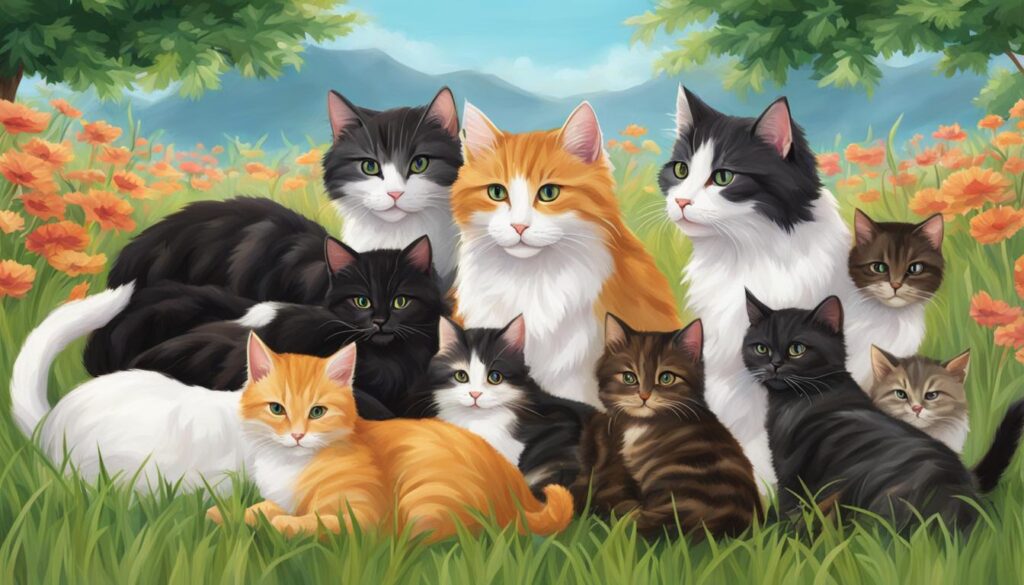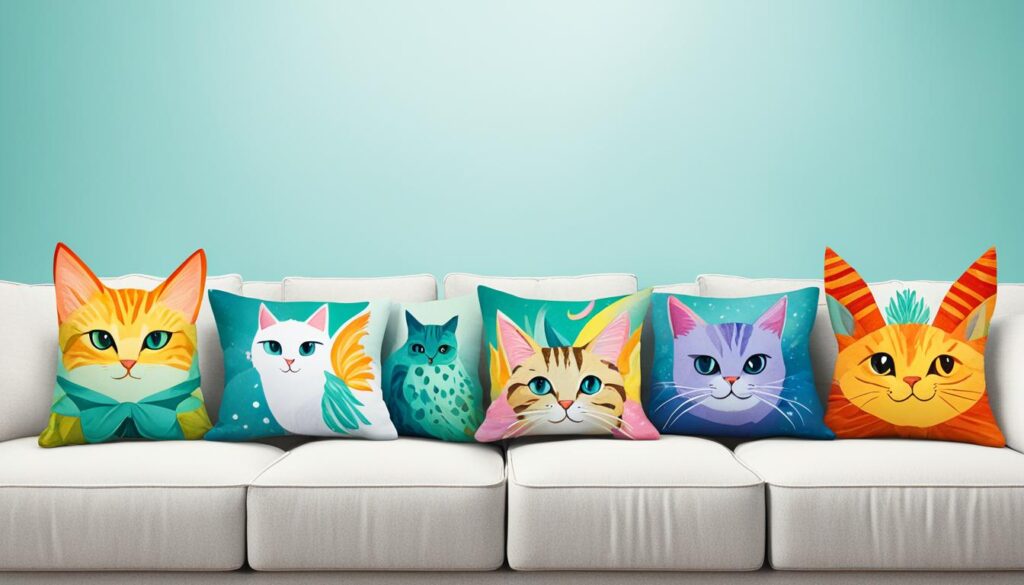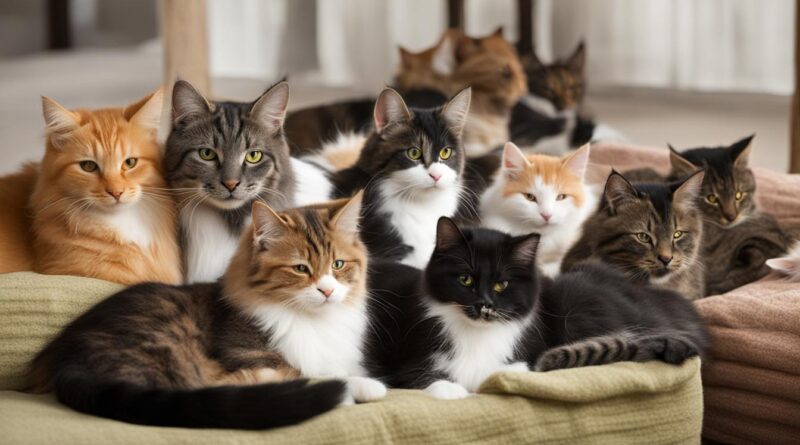What’s a Group of Cats Called? Find Out Here!
Have you ever wondered what a group of cats is called? Cats are known for their independent nature, but they also have social tendencies that manifest in the form of feline social groups. Whether it’s a cat colony, a cat collective, a cat gang, or a cat community, these groups of cats provide fascinating insights into their social dynamics and interactions.
So, what is the term commonly used to describe a group of cats? Well, it’s called a clowder! When three or more cats come together, they form a clowder. This charming term highlights the unique social bonds and behaviors within the feline world. Other terms used to describe a group of cats include clutter, glaring, and pounce.
Additionally, groups of kittens are often referred to as a litter, intrigue, or kindle. These terms further emphasize the adorable and playful nature of these little feline bundles.
Now that you know the terms for groups of cats, let’s explore the origins of the term “clowder” and dive deeper into the intriguing world of cat colonies and social behavior.
Key Takeaways:
- A group of cats is called a clowder.
- Other terms used for a group of cats include clutter, glaring, and pounce.
- Groups of kittens are referred to as a litter, intrigue, or kindle.
- The term “clowder” originates from the English word “clotern.”
- Cats can form social groups called cat colonies, which provide protection and companionship.
The Origins of the Term “Clowder”
The word clowder, used to describe a group of cats, has English origins and is derived from the word “clotern.” This term is related to other words such as clot, clutter, and cluster, which all indicate the gathering or coming together of objects. From a linguistic perspective, the term clowder reflects the innate nature of cats to form social bonds and interact with one another. This term adds a touch of whimsy to the already fascinating world of feline social groups.
Origins and Meaning
The term clowder can be traced back to Middle English and Old English, where it originally referred to a ball of thread or yarn. Over time, the word evolved to include the concept of objects gathering together, which eventually came to encompass groups of cats. This evolution in the word’s meaning highlights the centuries-old recognition of cats’ tendency to form social groups.
“The term ‘clowder’ is believed to have originated from Middle English and Old English, and it was initially used to describe a ball of thread or yarn. However, over time, it took on the meaning of objects gathering or clustering together. Inspired by this concept, the term ‘clowder’ began to be applied to groups of cats, emphasizing their natural inclination to form social bonds.”
The Social Nature of Cats
Cats are often associated with independence and solitary behavior, but the reality is that they have a complex social structure. The term clowder encapsulates the social nature of cats, highlighting their ability to form bonds and interact with other members of their group. While cats are capable of living alone, they also thrive in the presence of other cats and enjoy engaging in activities together.
Unlike some other social animals, such as dogs or pack animals, cats do not form hierarchical social structures. Instead, they tend to establish more flexible and egalitarian relationships within their clowder. This allows for a sense of camaraderie and companionship without rigid dominance hierarchies.
Clusters, Clot, and Clowder
- Clot: The word “clot” is used to describe a semi-solid mass or a thick, viscous liquid, often associated with coagulated blood or congestion. It shares the same linguistic root as “clowder,” as both terms originally referred to objects gathering or clustering together.
- Clutter: “Clutter” is a term used to describe a messy collection of objects that are disorderly or crowded together. This word also stems from the same linguistic origins as “clowder,” emphasizing the concept of things gathering together in a haphazard manner.
- Clowder: Derived from “clotern,” the word “clowder” specifically refers to a group of cats. It carries the connotation of cats gathering together while maintaining their individuality and independence within the social unit.
Cat Colonies and Social Behavior
Cats are typically known as solitary creatures, but they have the ability to form social groups called cat colonies. These colonies commonly consist of feral or wild cats that come together for protection and social bonding. While cats within a colony may not hunt together like dogs or wolves, they rely on each other for support and companionship. This social behavior can also be observed in domesticated cats, especially when they live together in a household with multiple cats. These cats may form their own mini cat colonies or feline squads, exhibiting a sense of camaraderie and hierarchy within the group.
Did you know? Cat colonies often establish a pecking order, with dominant cats assuming leadership roles and less dominant cats following their lead. This hierarchy helps maintain order and reduces conflicts within the group.
| Benefits of Cat Colonies | Challenges of Cat Colonies |
|---|---|
| 1. Increased protection against predators | 1. Limited resources, such as food and shelter |
| 2. Social interaction and companionship | 2. Potential for the spread of diseases |
| 3. Cooperative parenting and shared caretaking | 3. Competition for mating rights |
Despite the challenges, cat colonies provide a fascinating glimpse into the complex social behaviors of these independent and mysterious creatures. Whether they are a cat colony in the wild or a group of feline friends living together in a home, these cat packs or cat families demonstrate the power of social bonds and the unique dynamics that exist within the feline world.

The Benefits and Challenges of Cat Colonies
Cat colonies offer various advantages and face specific obstacles. Here’s a closer look at what makes them both beneficial and challenging:
- Increased protection against predators: By forming a cat colony, cats can better defend themselves against common predators, such as coyotes or rival animals that might threaten their safety.
- Social interaction and companionship: Cat colonies provide opportunities for cats to engage in social behaviors, which can alleviate loneliness and provide mental stimulation.
- Cooperative parenting and shared caretaking: In a cat colony, cats may take turns caring for kittens and share responsibilities for grooming, feeding, and protecting the young.
- Limited resources, such as food and shelter: In densely-populated cat colonies, competition for resources can arise, leading to conflicts and potential scarcity of vital necessities.
- Potential for the spread of diseases: When cats live in close proximity, there is an increased risk of disease transmission, particularly if proper healthcare measures are not in place.
- Competition for mating rights: Male cats within a colony may compete for the chance to mate with females, leading to territorial disputes and fights.
Understanding the dynamics of cat colonies is crucial for those who care for feral cats or have multiple cats in their homes. By providing appropriate resources, veterinary care, and preventing overpopulation, cat colonies can thrive, promoting the well-being of these social feline communities.
Unusual Names for Individual Cats
In addition to the curious names for groups of cats, there are also peculiar names for individual cats. A male cat is commonly referred to as a tom, while a neutered male cat is known as a gib. Female cats are often called molly, and a pregnant cat is referred to as a queen. These names add an element of uniqueness and charm to our feline companions. Furthermore, the term “moggy” is a British term for a feline mutt, while other more common labels include “house cat,” “alley cat,” and “domestic shorthair.” Each of these names highlights the individuality and diversity within the feline world.
| Gender | Name |
|---|---|
| Male (unneutered) | Tom |
| Male (neutered) | Gib |
| Female | Molly |
| Pregnant | Queen |

Conclusion
Understanding the terminology used to describe a group of cats provides valuable insight into their social dynamics and behaviors. Whether it’s a clowder, cat colony, or feline squad, cats possess the remarkable ability to form strong bonds and relationships with one another. Exploring the various names for groups of cats adds an element of intrigue and fun to our understanding of their social structures. So, the next time you come across a gathering of cats, you can confidently refer to them as a clowder, acknowledging the rich cat community they belong to.
FAQ
What is a group of cats called?
A group of cats is commonly referred to as a clowder. Other terms used to describe a group of cats include clutter, glaring, and pounce.
What are the origins of the term “clowder”?
The term “clowder” has English origins and is derived from the word “clotern.” It reflects the innate nature of cats to form social bonds and interact with one another.
What is a cat colony?
A cat colony refers to a social group of cats, which can consist of feral or wild cats that come together for protection and social bonding.
Do domesticated cats also form social groups?
Yes, domesticated cats can form their own mini cat colonies or feline squads, exhibiting a sense of camaraderie and hierarchy within the group.
Are there specific names for individual cats?
Yes, a male cat is commonly referred to as a tom, while a neutered male cat is known as a gib. Female cats are often called molly, and a pregnant cat is referred to as a queen.
Are there any other names for cats?
Yes, “moggy” is a British term for a feline mutt, while other more common labels include “house cat,” “alley cat,” and “domestic shorthair.”


